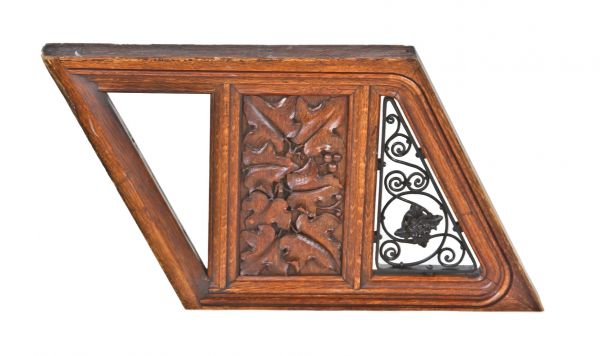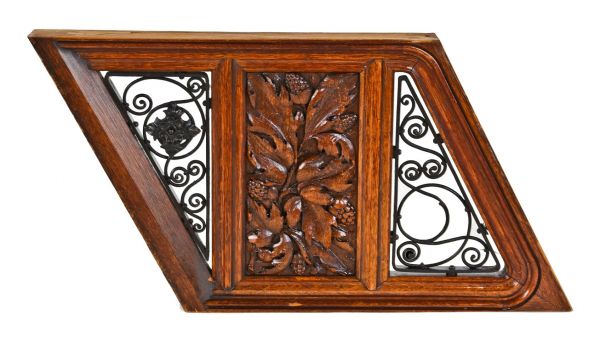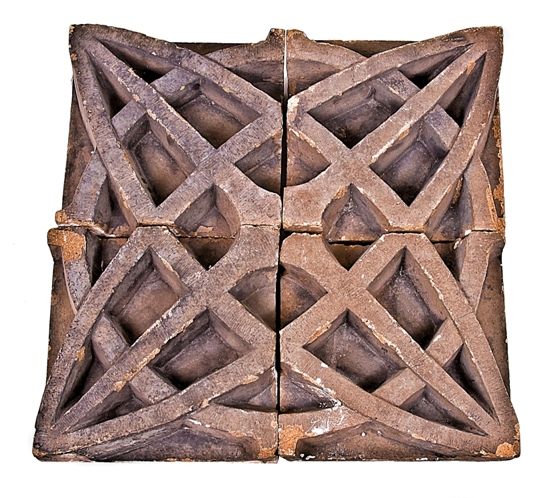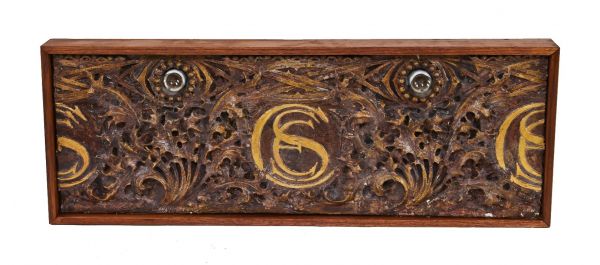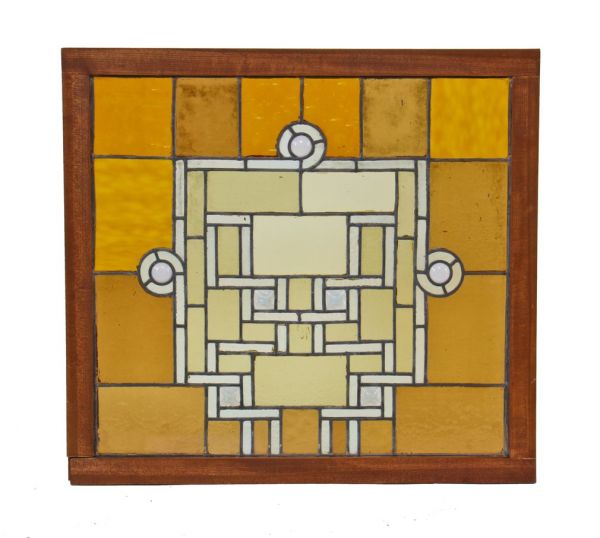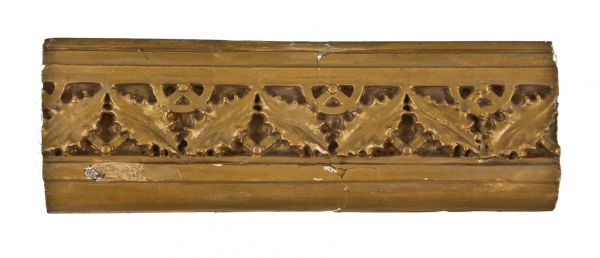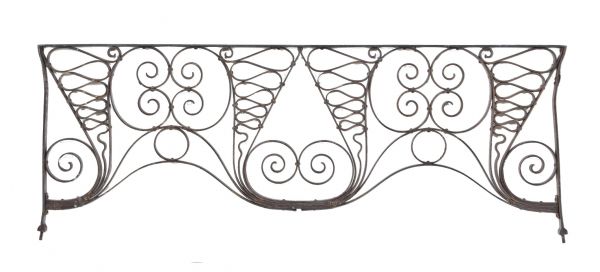original and unrestored 19th century antique american interior residential potter palmer mansion partial intact staircase section with elaborate carving and iron work
SOLD
Out of stock
SKU
UR-20080-14
cobb & frost, architects
largely intact single historically important late 19th century unrestored american quartered white oak wood and wrought iron potter palmer mansion interior staircase angled railing section. the thoroughly documented residential staircase railing was salvaged from the palmer mansion prior to demolition in 1950. the railing section features a single-sided hand-carved panel featuring very intricate leafage and berries in deep relief. the spaces between the carved panel contain very ornate and delicate wrought iron (one section is missing entirely) with the original black enameled finish intact. the staircase was constructed by or under the supervision of john newquist. the exact fabricator and/or foundry (that executed the iron panels) is not known. the interior side of the railing section, which faced the treads and risers, contains am unornamented beveled edge wood panel. the original varnished finish remains in great overall condition, considering age. the non-extant potter palmer mansion, constructed 1882–1885 at 1350 n. lake shore drive, was once the largest private residence in the city of chicago. the plamer mansion was located in the near north side neighborhood of the city, facing lake michigan. it was designed by architects henry ives cobb and charles sumner frost of the firm cobb and frost (navy pier, chicago athletic associaton, etc.), and built for potter and his wife bertha . palmer was a prominent chicago businessman who was responsible for much of the development of state street. the construction of the palmer mansion on lake shore drive established the "gold coast" neighborhood - still considered to be one of the most affluent neighborhoods in the city. at the time of the construction of the mansion, mr. palmer was already responsible for much of the development of state street. after the great chicago fire of 1871, the buildings (including the newly0built palmer house) on state street were destroyed, and palmer was yet again responsible for its redevelopment. construction on the mansion began in 1882, and its exterior work was completed in 1883. however, interior decoration by a number of notable interior designers would continue for another two years before the building was entirely complete. the interiors were completed under the direction of architect joseph lyman silsbee. john newquist, who had already worked with palmer on numerous other constructions, was chosen as the contractor and stair constructer. although it was originally budgeted at $90,000, after five years of construction, the mansion would cost the palmers more than a million dollars. the mansion featured a three-story italianate central hall under a glass dome. other rooms were finished in a variety of historic styles: a louis xvi salon, anindian room, an ottoman parlor, a renaissance library, a spanish music room, an english dining room that could seat fifty, and a moorish room, the rugs of which were saturated with perfumes. a collection of paintings, collected by bertha palmer, adorned the mansion's grand ballroom, 75-foot long. the room's murals in the frieze above them were by gabriel ferrier. the architects referred to its architectural style as early romanesque or norman gothic. alternatively, the mansion was supposedly based on a german castle. the mansion's exterior included many turrets and minarets, and on the interior, a spiral staircase without a center support, rising 80 feet into the central tower. two elevators also served the building. the palmers constructed their mansion's outside doors specifically without locks and knobs so that the only way to get in was to be admitted from the inside. the palmer mansion was used for many social gatherings, including entertaining former u. s. president ulysses s. grant, during his visit to the city, and receptions during the 1893 world's columbian exposition for which bertha palmer was a major planner and booster. the palmers also received many other guests, including: two other u. s. presidents, william mckinley and james a. garfield; the duke and duchess of veragua; the prince of wales, later to become king edward vii; as well as the spanish princess infanta eulalia. when potter palmer died in the mansion in 1902, he left his wife with a fortune of $8,000,000. after his death, bertha palmer continued to reside in the house, as well as in homes she maintained in london and paris, until she died at her winter residence in sarasota, florida. she invested heavily in real estate in florida where she developed farms, dairies, and cattle ranches that she administered herself. even with these great investments in land, she parleyed the fortune into almost double what she had been left and, in 1918, bequeathed an estate of $15,000,000 to her sons honoré and potter palmer, jr., who sold the chicago mansion in 1930, for $3,000,000, to the industrialist vincent hugo bendix, who had invented an automobile starter. bendix renamed the property "the bendix galleries," after adding paintings by rembrandt and howard chandler christy to bertha palmer's former art collection. while residing within the mansion, he modernized the elevator, and installed a barber's chair for his own use. after living on the property for about five years, vincent bendix announced that the mansion would be razed to allow construction of the world's largest hotel on the site, estimated at approximately $25,000,000. the project was never put into action, and the property was sold to potter palmer's son in 1933 for $2,000,000, the amount of the building's mortgage. the mansion stood vacant for years until it was demolished in 1950, to be replaced by two 22-story high-rise apartment buildings housing 740 families. the mansion's painting gallery, including works by french painters claude monet, pierre-auguste renoir, and edgar degas that were collected by bertha palmer, were transferred to the art institute of chicago, and the furniture was sold. multiple sections are available for sale. panels measure at 30 1/2 inches x 2 1/2 inches x 16 inches.
You Might Also Like
WORDLWIDE SHIPPING
If required, please contact an Urban Remains sales associate.
NEW PRODUCTS DAILY
Check back daily as we are constantly adding new products.
PREMIUM SUPPORT
We're here to help answer any question. Contact us anytime!
SALES & PROMOTIONS
Join our newsletter to get the latest information

